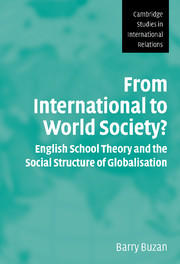 From International to World Society?
From International to World Society? Book contents
- Frontmatter
- Contents
- List of figures and tables
- Preface
- List of abbreviations
- Glossary
- Introduction
- 1 English school theory and its problems: an overview
- 2 World society in English school theory
- 3 Concepts of world society outside English school thinking
- 4 Reimagining the English school's triad
- 5 Reconstructing the pluralist–solidarist debate
- 6 The primary institutions of international society
- 7 Bringing geography back in
- 8 Conclusions: a portrait of contemporary interstate society
- List of references
- Index
- CAMBRIDGE STUDIES IN INTERNATIONAL RELATIONS
1 - English school theory and its problems: an overview
Published online by Cambridge University Press: 14 January 2010
- Frontmatter
- Contents
- List of figures and tables
- Preface
- List of abbreviations
- Glossary
- Introduction
- 1 English school theory and its problems: an overview
- 2 World society in English school theory
- 3 Concepts of world society outside English school thinking
- 4 Reimagining the English school's triad
- 5 Reconstructing the pluralist–solidarist debate
- 6 The primary institutions of international society
- 7 Bringing geography back in
- 8 Conclusions: a portrait of contemporary interstate society
- List of references
- Index
- CAMBRIDGE STUDIES IN INTERNATIONAL RELATIONS
Summary
We need sharper analytical tools than those provided by Wight and Bull.
Dunne (2001b: 66)This chapter starts with a summary of English school theory as it is conventionally understood. The second section looks at the different strands, tensions and potentials within the school, and locates within them the line to be taken in the rest of this book. The third section reviews the main areas of weakness in English school theory that subsequent chapters will address and hopefully rectify. The fourth section tackles the question of whether English school theory is really theory.
English school theory: a summary
The English school can be thought of as an established body of both theoretical and empirical work dating back to the late 1950s (Dunne 1998; Wæver 1998; Buzan 2001). Robert Jackson (1992: 271) nicely sums up the English school conversation by seeing it as:
a variety of theoretical inquiries which conceive of international relations as a world not merely of power or prudence or wealth or capability or domination but also one of recognition, association, membership, equality, equity, legitimate interests, rights, reciprocity, customs and conventions, agreements and disagreements, disputes, offenses, injuries, damages, reparations, and the rest: the normative vocabulary of human conduct.
Two core elements define the distinctiveness of the English school: its three key concepts, and its theoretically pluralist approach. The three key concepts are: international system, international society and world society (Little 1995: 15–16).
- Type
- Chapter
- Information
- From International to World Society?English School Theory and the Social Structure of Globalisation, pp. 6 - 26Publisher: Cambridge University PressPrint publication year: 2004


